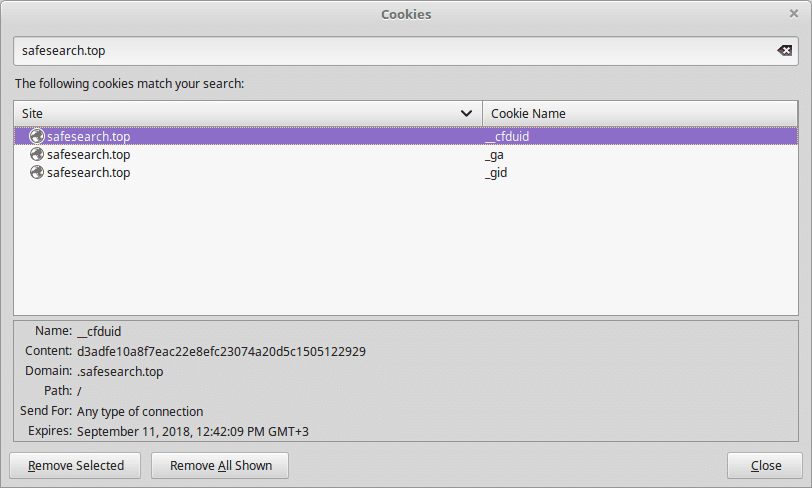Our guide shows how victims of the safesearch.top browser hijacker can remove the active infections and recover their browsers and computers.
Remove safesearch.top and Restore PC
Manual Removal Guide
Skip all steps and download anti-malware tool that will safely scan and clean your PC.
SpyHunter anti-malware tool will diagnose all current threats on the computer. By purchasing the full version, you will be able to remove all malware threats instantly. Additional information about SpyHunter / Help to uninstall SpyHunter
Symptoms and Consequences of safesearch.top Infection
safesearch.top is a dangerous browser hijacker that has been found to cause serious problems to the privacy of its victims. Upon infection with it the victims will find that they will find that the majority of the browsers will have altered settings. Browser hijackers like safesearch.top have the goal of redirecting the victims to a hacker-controlled site or infect the victims with different forms of malware.
In most cases the hackers behind the site devise special plugins that change the settings of the most popular browsers: Mozilla Firefox, Google Chrome, Internet Explorer, Safari, Opera and Microsoft Edge. This is done to redirect the victims to a hacker-operated site by changing the following options: default home page, new tabs page and search engine. The safesearch.top site appears to be a malicious site that poses as a legitimate service.
Once the users visit the site several different tracking cookies are imposed. They are used for several different purposes:
- Behavior Tracking ‒ The cookies are used to automatically track the users by deploying the cookies. They keep a detailed record of all site interactions, the data is then relayed to the hacker operators.
- Information Harvesting ‒ By using the cookies the hackers can harvest sensitive information stored from the victim computers.

In addition private data is stolen from the browsers, including the following: passwords, history, bookmarks, account credentials, settings and any stored passwords. The information is sent to the malicious operators and can be used for various crimes including financial abuse and identity theft.
Once the victims visit the safesearch.top malicious site they will be shown a familiar looking user interface. The designers of the hacker-controlled site utilize the stolen cookies and attempt to display information and ads that may seem relevant to the interests of the victims.
The safesearch.top browser hijacker uses a hacker-controlled ad network and displays several links to popular Internet services in an attempt to make the site appear as a real portal. Note that any interaction with links or contents of any time can lead to a dangerous malware infection. Browser hijackers like this one are usually used for delivering viruses of different types (including ransomware) to computer users worldwide. When a search query is the results are shown in a Hebrew-language site that showcases primarily sponsored results. They do not represent the best results and may confuse or otherwise hide the legitimate addresses.

One of the leading reasons why the safesearch.top should be avoided is the fact that no privacy policy or terms of use page is displayed on the front page. The lack of information means that in practice the hacker operators can cause serious security issues without notifying the victims.
A quality anti-spyware solution can effectively remove the infection and restore the security of the browser and computer.
Where Did My PC Get Infected With The safesearch.top Browser Hijacker?
The safesearch.top browser hijacker can be acquired from different sources. One of the primary ways of delivering threats like this is the use of fake download sites. The hackers behind the threat follow the typical design templates and attempt to mimic well-known portals that capture the interest of the victims. Usually they are advertised in spam email messages, social networks (via fake accounts) or other means. The sites distribute the safesearch.top executable either bundled on its own or as part of a software installer. Depending on the cases the intended victims may be able to evade the infection by unchecking options during the installation process.
In the last few months we have seen a rise in the popups and relatede notifications that are usually found on various sites. Malware code and links to the safesearch.top browser hijackers can be acquired from visiting such places. P2P networks like BitTorrent are a popular source of such instances.
Remove safesearch.top Redirect and Restore PC
WARNING! Manual removal of the safesearch.top browser hijacker requires being familiar with system files and registries. Removing important data accidentally can lead to permanent system damage. If you don’t feel comfortable with manual instructions, download a powerful anti-malware tool that will scan your system for malware and clean it safely for you.
SpyHunter anti-malware tool will diagnose all current threats on the computer. By purchasing the full version, you will be able to remove all malware threats instantly. Additional information about SpyHunter / Help to uninstall SpyHunter
safesearch.top – Manual Removal Steps
Start the PC in Safe Mode with Network
This will isolate all files and objects created by the ransomware so they will be removed efficiently. The steps bellow are applicable to all Windows versions.
1. Hit the WIN Key + R
2. A Run window will appear. In it, write msconfig and then press Enter
3. A Configuration box shall appear. In it Choose the tab named Boot
4. Mark Safe Boot option and then go to Network under it to tick it too
5. Apply -> OK
Remove safesearch.top from Windows
Here’s a way to remove the program. This method will work regardless if you’re on Windows 10, 8, 7, Vista or XP. Simply selecting the program and pressing delete won’t work, as it’ll leave a lot of small files. That’s bad because these leftovers can linger on and cause all sorts of problems. The best way to delete a program is to uninstall it. Here’s how you can do that:
1. Hold the “Windows” button (It’s between CTRL and Alt on most keyboards) and press “R”. You’ll see a pop-up window.

2. In the textbox, type “appwiz.cpl”, then press“ Enter ”.

3. The “Programs and features” menu should now appear. It’s a list of all the programs installed on the PC. Here you can find the program, select it, and press “Uninstall“.

Remove safesearch.top Virus From Your Browser
Before resetting your browser’s settings, you should know that this action will wipe out all your recorded usernames, passwords, and other types of data. Make sure to save them in some way.
-
1. Start Mozilla Firefox. In the upper right corner, click on the Open menu icon and select “Add-ons“.

2. Inside the Add-ons Manager select “Extensions“. Search the list of extensions for suspicious entries. If you find any, select them and click “Remove“.

3. Click again on the Open menu icon, then click “Options“.

4. In the Options window, under “General” tab, click “Restore to Default“.

5. Select “Search” in the left menu, mark the unknown search engine and press “Remove”.

-
1. Start Google Chrome. On the upper-right corner, there a “Customize and Control” menu icon. Click on it, then click on “Settings“.

2. Click “Extensions” in the left menu. Then click on the trash bin icon to remove the suspicious extension.

3. Again in the left menu, under Chrome, Click on “Settings“. Go under “On Startup” and set a new page.

4. Afterward, scroll down to “Search“, click on “Manage search engines“.

5. In the default search settings list, find the unknown search engine and click on “X“. Then select your search engine of choice and click “Make default“. When you are ready click “Done” button in the right bottom corner.

2. In the “Manage add-ons” window, bellow “Add-on Types“, select “Toolbars and Extensions“. If you see a suspicious toolbar, select it and click “Remove“.

3. Then again in the “Manage Add-ons” window, in “Add-on Types“, Select “Search Providers“. Chose a search engine and click “Set as default“. Select the unknown search engine and click “Remove and Close”.

4. Open the Tools menu, select “Internet Options”.

5. In the “General” tab, in “Home page”, enter your preferred page. Click “Apply” and “OK”.

Repair Windows Registry
1. Again type simultaneously the WIN Key + R key combination
2. In the box, write regedit and hit Enter
3. Type the CTRL+ F and then write the malicious name in the search type field to locate the malicious executable
4. In case you have discovered registry keys and values related to the name, you should delete them, but be careful not to delete legitimate keys
Click for more information about Windows Registry and further repair help



